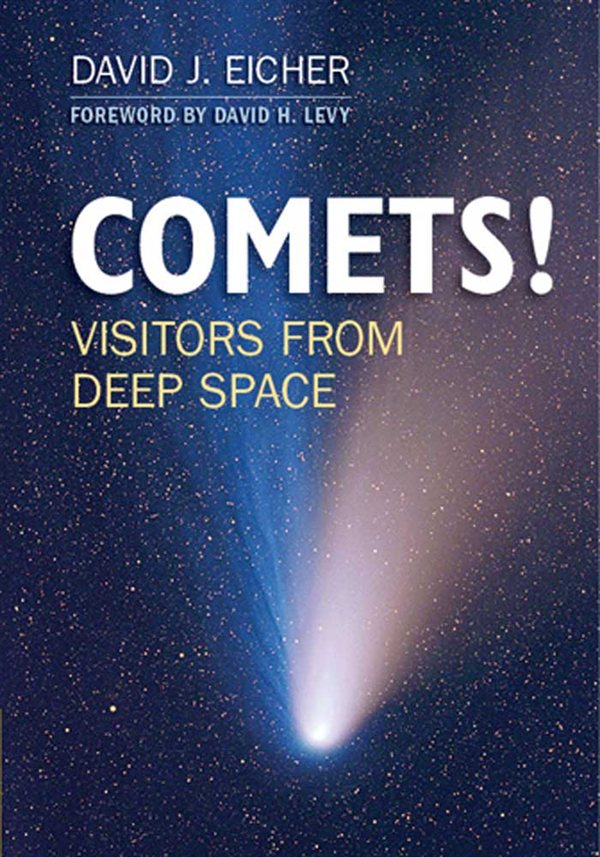 My book, COMETS! Visitors from Deep Space, will be published by Cambridge University Press this October. Here’s a taste of an introductory chapter that describes where comets live in the solar system.
My book, COMETS! Visitors from Deep Space, will be published by Cambridge University Press this October. Here’s a taste of an introductory chapter that describes where comets live in the solar system.
Enjoy!
Given the incredible uncertainty of most early observers over the distances to comets, it’s impressive that by the mid-19th century, the majority of scientists came to believe that comets have orbits larger than the planets. The beginning of a modern division of cometary orbits, and therefore groups or families of comets, originated with Irish astronomer and science writer Dionysius Lardner (1793–1859), compiler of the 133-volume Cabinet Cyclopedia, who wrote in 1853, “We are in possession of the elements of the motions of 207 comets. It appears that 40 move in ellipses, 7 in hyperbolas, and 160 in parabolas.”
Lardner’s analysis suggested three classes with elliptical orbits, and they have come to be known as Jupiter-family comets, Halley-type comets, and long-period comets. Hyperbolic and parabolic orbits are new long-period comets whose orbits have not yet evolved into huge ellipses. Lardner also looked at the direction of cometary motions, noting that — not counting the Jupiter-family comets — roughly equal numbers exist of comets that orbit in the same direction as the planets and those that orbit in the opposite direction.
The murky origins of comets received further study from American astronomer Hubert A. Newton (1830–1896) and Dutch astronomer Adrianus J. J. van Woerkom (1915–1991), who focused on the gravitational effects of Jupiter. In 1948, van Woerkom studied the orbits of comets and demonstrated that their energies were not consistent with an interstellar origin. Two years later, Dutch astronomer Jan H. Oort (1900-1992) wrote his game-changing paper that tied the questions of cometary origins together. “There is no reasonable escape,” he penned, “I believe, from the conclusion that the comets have always belonged to the solar system. They must then form a huge cloud, extending . . . to distances of at least 150,000 [astronomical units] and possibly still further.”
So the Oort Cloud, the distant, enormous shell of comets surrounding the solar system, came to be held up by astronomers as the principle storehouse of comets in our vicinity. This is the home of long-period comets, of where these objects in their huge orbits flutter out to incredible distances and with orbits that remain stable over billions of years, sometimes coming in close to our neck of the woods, warming up, and becoming gossamer parts of the sky. Just exactly why do astronomers believe this to be so? And how do long-period comets behave?
Along with the planets, the young solar system contained a large number of so-called planetesimals, small icy and rocky bodies between the planets and on the solar system’s outer edges. The region of about 4 to 40 astronomical units from the Sun (from a little closer than Jupiter to the region just beyond Pluto), where ices would be able to be vaporized, would have contained countless planetesimals. Most of these planetesimals would have been perturbed by the planets into orbits that would have crossed the plane of planetary orbits, sweeping them up. This is except for the Kuiper Belt, the region of small icy bodies from about 35 astronomical units out, where the orbits could remain stable for billions of years.
Long-period comets were probably born from the planetesimals that didn’t remain in stable orbits. Planetary scientists think the movement of a comet from the outer area of planets all the way out into the Oort Cloud happens over several discrete steps. First, perturbations from planets need to kick the icy object into a more energetic orbit — that is, keeping its perihelion distance about the same while it lengthens the semimajor axis of the orbit. This makes the orbit larger and larger, sending it out deeper into the abyss at its farthest point from the Sun.
But there has to be a limit to this process, or the comet would eventually escape into deep space, captured by the gravity of a passing star or cloud of gas while the Sun loses its gravitational hold on the comet. Decades ago, astronomers argued that stars and other distant objects can actually provide a stabilizing effect on comets undergoing this lengthening of their orbits. In 1932, Estonian astronomer Ernst Öpik (1893–1985) and, 18 years later Oort himself, suggested that stars could indeed affect the orbits of comets. But rather than stealing the comet by gravity, a passing star could place it neatly in the Oort Cloud if it readjusts the comet’s perihelion away from the region of the planets, before planets knock the comet out of the solar system. Comets that stay in the Oort Cloud have their orbits perturbed into a large semimajor axis that is affected by passing stars but are not perturbed so much to push it so far away that the comet is weakly bound to the solar system.
Planetary scientists thus believe that planetesimals that were strongly perturbed by planets and placed into orbits with semimajor axes of 10,000 to 100,000 astronomical units inhabit the Oort Cloud. Comets perturbed out to greater distances probably escaped the Sun’s gravity, and those not perturbed enough crossed the plane of the planets and were long ago accreted into larger bodies. The great shooting gallery of the solar system found a way to incorporate many small bodies into the larger ones, to sling most of them far away into a frozen holding bin, and to eject many others into interstellar space. But because passing stars pass in random directions, some of the Oort Cloud comets they knock about by gravity find their way directed inward toward the Sun, reducing their perihelion distances and sending them toward us for a close encounter with the inner solar system.